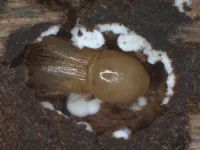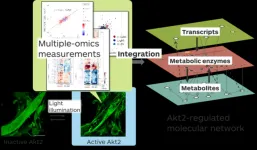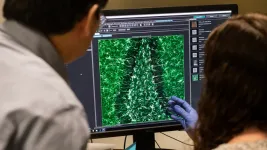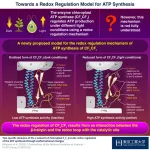(Press-News.org) The mass outbreaks of bark beetles observed in recent years have caused shocking amounts of forest damage throughout Germany. As reported by the Federal Statistical Office in July 2022, more than 80% of the trees that had to be felled in the previous year were damaged by insects. The damaged timber felled due to insect damage amounted to more than 40 million cubic meters. One of the main pests is the European spruce beetle Ips typographus. In the Thuringian Forest and the Harz Mountains, for example, the beetle, which is only a few millimeters long, encountered spruce monocultures that had already been weakened by high temperatures and extended periods of drought, which facilitated the spread of the pest and led to the death of huge forest stands within a short period of time.
Researchers have already known that chemical communication plays an important role in bark beetle mass attacks. Beetles first choose a suitable tree and then emit so-called aggregation pheromones. These pheromones attract conspecifics in the vicinity to join a mass attack that overcomes the tree’s defenses. Spruce trees whose defenses are already weakened by stresses are more readily overcome.
Bark beetles like the odor of their symbiotic fungi
Spruce bark beetles need fungal allies to successfully reproduce in the trees. The fungi are ectosymbionts, symbiotic partners that live outside the beetles. Each new generation of beetles must find their symbiotic fungi and carry them to a new host tree.
In a new study, an international research team led by Dineshkumar Kandasamy (now at Lund University, Sweden) and Jonathan Gershenzon of the Max Planck Institute for Chemical Ecology in Jena, Germany, reports that the European spruce bark beetle can find its fungal partners based on the volatile chemical compounds the fungi release when they degrade spruce resin components. “We had already been able to show that bark beetles are attracted to their fungal associates when these are cultured on standard fungal growth medium. Now we wanted to know what would happen if we grew fungi on a more natural medium with spruce bark powder added. Would beetles be attracted to fungi now? If so, which chemical compounds would be responsible for the attraction and what is the origin of these chemicals?” says first author Dineshkumar Kandasamy, explaining the study's initial questions.
Fungi convert the chemical defenses of spruce into attractants for the beetles
European spruce bark beetles are associated with fungal partners of different genera. The fungus Grosmannia penicillata grew particularly well on the spruce bark medium and produced more volatile compounds than most of the other fungi tested. Therefore the researchers focused their investigations on this fungus. The researchers set up special experimental arenas where they could test whether the beetles were attracted to volatile compounds emitted by the fungi.
“We first found that European spruce bark beetles are attracted to the volatiles emitted by their associated fungi when fungi were growing on medium with spruce bark powder. However, we also showed that fungi can transform terpene compounds from spruce resin into their oxygenated derivatives and that some of these metabolites produced by fungi are particularly attractive to bark beetles. The overall conclusion is that these volatiles serve as chemical signals that keep the symbiosis between bark beetles and their associated fungi going," says Dineshkumar Kandasamy.
The researchers found that pathogenic fungi, which are harmful to the beetles, can also metabolize spruce resin compounds. However, unlike the metabolites of the symbiotic fungi, the resulting derivatives are not attractive to bark beetles. Bark beetles can therefore use their sense of smell to distinguish whether the fungi present in the tree are good or bad for them. The scientists were particularly surprised when the behavioral observations revealed that fungal partners not only attracted the beetles but also stimulated them to tunnel.
Bark beetles have olfactory sensory cells in their antennae tuned to detect volatile compounds of fungal metabolism
Further evidence that fungal metabolites make spruce trees already infested by fungi even more attractive to bark beetles was provided by electrophysiological studies of the beetles' perception of these odors. This involved testing the response of individual olfactory sensilla on the beetle antennae to different odors. The researchers were able to show that the bark beetles possess certain olfactory sensory neurons housed in sensilla that are specialized in detecting oxygenated monoterpenes emitted by the fungi.
“By enhancing bark beetle attraction to particular trees, volatiles from the fungus could increase the intensity and success of mass attacks. Fungi may help kill the host tree, overcome its defenses, provide beetles with nutrients or protect them from pathogens. The ability of the fungus to metabolize resin components that are originally produced by the tree as a defense could indicate which fungi are virulent and could serve as good partners for the beetle," says Jonathan Gershenzon.
The results of this new study may help improve the control of bark beetle outbreaks. One of the most widely used strategy in the fight against these pests are pheromone traps, but these have not been effective in preventing recent outbreaks. Therefore, the researchers are now testing whether these odor traps can be optimized by adding oxygenated monoterpenes from fungal metabolism. An important goal for the research team is to learn more about the metabolism of the spruce resin compounds in the fungi and to find out whether this can be a detoxification reaction for the fungus or for the beetle.
Dineshkumar Kandasamy is currently supported by the Max Planck Center next Generation Insect Chemical Ecology research network, a Max Planck Society-funded collaboration of the Max Planck Institute for Chemical Ecology with Lund University and the Swedish University of Agricultural Sciences. The Max Planck Center aims to study the impact of anthropogenic global warming and air pollution on insect chemical communication. The focus is not only on pests, but also on pollinators and their ecosystem services, as well as insects that carry and transmit pathogens.
END
Symbiotic fungi transform terpenes from spruce resin into attractants for bark beetles
When metabolizing spruce bark, the insect’s fungal partners release volatile compounds that bark beetles recognize through specialized olfactory sensory neurons
2023-02-21
ELSE PRESS RELEASES FROM THIS DATE:
Shining light on an enzyme reveals its role in metabolism
2023-02-21
Takeaki Ozawa and his team from the University of Tokyo reveal the metabolic reactions upon activating an enzyme called Akt2. In doing so, they reveal the inner workings of insulin-regulated metabolism. The findings lead the way for Akt2-targeting therapeutics for diabetes and metabolic disorders.
It takes energy to do anything—even to exist. You can metabolize food to convert glucose into energy: thanks to many cascades of molecular reactions within your cells. As soon as you eat, your pancreas secretes insulin hormone, which starts ...
Impact of key Alzheimer’s protein depends on type of brain cell in which it is produced
2023-02-21
SAN FRANCISCO, CA—February 21, 2023—Of all the known genetic risk factors for late-onset Alzheimer’s disease, the strongest is a gene for the protein called ApoE4. People with one copy of this gene are 3.5 times more likely, on average, to develop Alzheimer’s than others, and those with two copies face a 12-fold increased risk. However, exactly how ApoE4 boosts the risk of Alzheimer’s remains unclear.
Multiple types of cells in the brain make ApoE4—some of it is produced by neurons, but other brain cells called glia make it in higher quantities. For that reason, most prior research on this protein has focused on ...
Douglas Rhoads named AAAS Fellow
2023-02-21
University Professor Douglas Rhoads has been named a Fellow of the American Association for the Advancement of Science, the world’s largest general scientific society and publisher of the journal Science.
As one of only 20 fellows representing the Section on Agriculture, Food & Renewable Resources, Rhoads was chosen by his peers and colleagues for advancing science and its applications in service to society. The organization elected a total of 505 fellows across 24 scientific sections.
Rhoads is director of the Interdisciplinary ...
Pill for skin disease also curbs excessive drinking
2023-02-21
Researchers from Oregon Health & Science University and institutions across the country have identified a pill used to treat a common skin disease as an “incredibly promising” treatment for alcohol use disorder.
The study was recently published in the Journal of Clinical Investigation.
On average, the people who received the medication, called apremilast, reduced their alcohol intake by more than half — from five drinks per day to two.
“I’ve never seen anything like that before,” said co-senior author Angela Ozburn, Ph.D., associate professor of behavioral neuroscience in the OHSU School of Medicine and a research biologist ...
University of Ottawa physician is first Canadian winner of new award focused on health workforce wellness
2023-02-21
The University of Ottawa's Dr. Mamta Gautam is the first awardee of the AFMC Wellness Award, a new national honour that recognizes an individual in Canada who has shown dedication to the promotion and advancement of the wellness of physicians, medical students, and others.
“I am truly humbled and honoured. Promoting physician wellbeing is an area that I have been passionate about for over 30 years. To have the AFMC create an award to recognize contributions in this area lends further credibility to the importance of this topic,” ...
Researchers discover mysterious source of 'heartbeat-like' radio bursts in a solar fare
2023-02-21
A solar radio burst with a signal pattern, akin to that of a heartbeat, has been pinpointed in the Sun’s atmosphere, according to a new study.
In findings published in the journal Nature Communications, an international team of researchers has reported uncovering the source location of a radio signal coming from within a C-class solar flare more than 5,000 kilometers above the Sun’s surface.
Researchers say the study’s findings could help scientists better understand the physical processes behind the energy release of solar flares — the solar system’s most powerful explosions.
“The ...
Three talented researchers recognized as endowed chairs
2023-02-21
Huntsman Cancer Institute at the University of Utah (The U) is pleased to congratulate three of our newest endowed chairs. A chair appointment recognizes excellence, while providing academic distinction and funding for future research. Alana Welm, PhD, received a five-year extension in her current role as Ralph E. and Willia T. Main Presidential Endowed Chair in Cancer Research, Aik Choon Tan, PhD, was named the Jon and Karen Huntsman Presidential Professor in Cancer Research, and Brad Cairns, PhD, was named ...
New transmitter design for small satellite constellations improves signal transmission
2023-02-21
Today, there are many emerging applications for small satellite constellations, ranging from space-borne networks to environmental monitoring. However, small satellites have special needs when it comes to transmitter (TX) technology. For one, they have stringent limitations on power consumption as they draw energy from solar panels and cannot easily dissipate generated heat. Moreover, small satellites need to communicate with fast-moving targets that can be over a thousand kilometers away. Thus, they require efficient and precise beam steering capabilities to direct most of the transmitted power ...
Improving the performance of satellites in low Earth orbit
2023-02-21
A database updated in 2022 reported around 4,852 active satellites orbiting the earth. These satellites serve many different purposes in space, from GPS and weather tracking to military reconnaissance and early warning systems. Given the wide array of uses for satellites, especially in low Earth orbit (LEO), researchers are constantly trying to develop better ones. In this regard, small satellites have a lot of potential. They can reduce launch costs and increase the number of satellites in orbit, providing a better network with wider coverage. ...
Researchers uncover how photosynthetic organisms regulate and synthesize ATP
2023-02-21
ATP, the compound essential for the functioning of photosynthetic organisms such as plants, algae, and cyanobacteria, is produced by an enzyme called “chloroplast ATP synthase” (CFoCF1). To control ATP production under varying light conditions, the enzyme uses a redox regulatory mechanism that modifies the ATP synthesis activity in response to changes in the redox state of cysteine (Cys) residues, which exist as dithiols under reducing (light) conditions, but forms a disulfide bond under oxidizing (dark) conditions. ...
LAST 30 PRESS RELEASES:
Exploring how patients feel about AI transcription
Category ‘6’ tropical cyclone hot spots are growing
Video: Drivers struggle to multitask when using dashboard touch screens, study finds
SLU research shows surge in alcohol-related liver disease driving ‘deaths of despair’
Rising heat reshapes how microbes break down microplastics, new review finds
Roots reveal a hidden carbon pathway in maize plants
Membrane magic: FAMU-FSU researchers repurpose fuel cells membranes for new applications
UN Member States pledge to increase access to diagnosis and inhaled medicines for the 480 million people living with COPD
Combination therapy shows potential to treat pediatric brain cancer ATRT
Study links seabird nesting to shark turf wars in Hawai‘i
Legal sports betting linked to sharp increases in violent crime, study finds
Breakthrough AI from NYUAD speeds up discovery of life-supporting microbes
New Eva Mayr-Stihl Foundation funding initiative boosts research at University of Freiburg on adaptation of forests to global change
The perfect plastic? Plant-based, fully saltwater degradable, zero microplastics
Bias in data may be blocking AI’s potential to combat antibiotic resistance
Article-level metrics would provide more recognition to most researchers than journal-level metrics
Satiety’s little helper: Protein that supports appetite regulating protein identified
UF dives deep into predicting storm damage with computer models
A stormy ocean voyage yields insights on the global carbon cycle
Scientists identify first non-coding gene that controls cell size
Demonstration of altermagnetism in RuO₂ thin films -- A new magnetic material for the AI era
Penn researchers awarded $25M to conduct trial using smartphones to fight heart disease
PCORI awards funding for new patient-centered healthcare research
Exploring the origins of the universe: 145 low-noise amplifiers complete ALMA telescopes
Empress cicada wings help illuminate molecular structure
Using sound waves to detect helium
Time burden in patients with metastatic breast and ovarian cancer from clinic and home demands
Researchers discover bias in AI models that analyze pathology samples
Scientists ID potential way to prevent brain injuries from triggering Alzheimer's
MASTER 2nd Open Call: Execution period kick-off
[Press-News.org] Symbiotic fungi transform terpenes from spruce resin into attractants for bark beetlesWhen metabolizing spruce bark, the insect’s fungal partners release volatile compounds that bark beetles recognize through specialized olfactory sensory neurons










